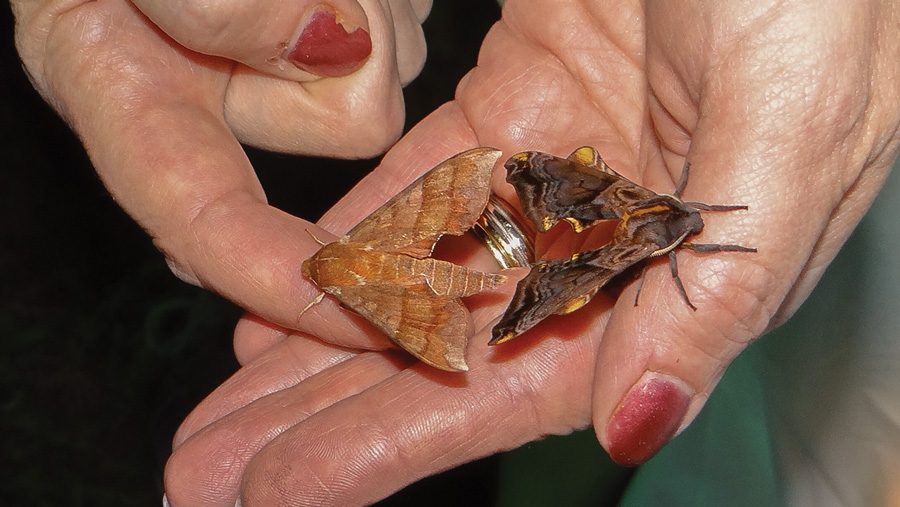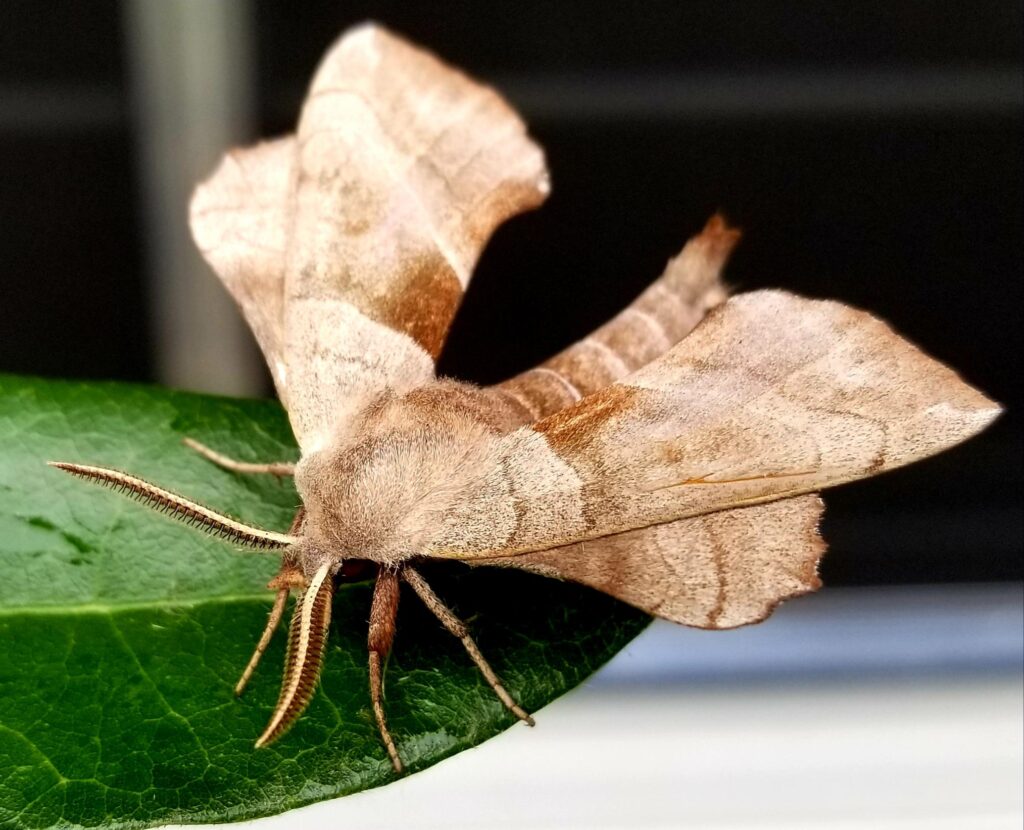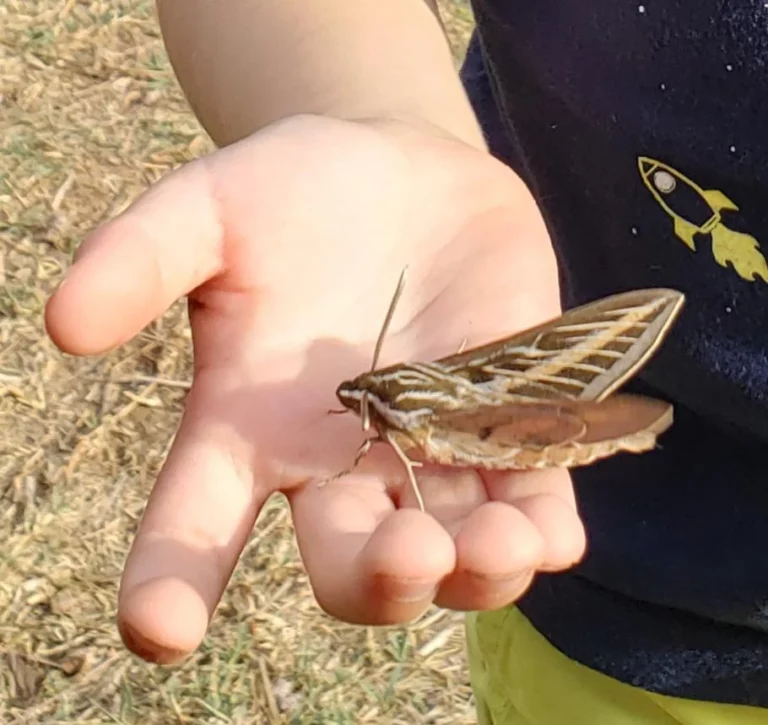Moths vibrate for various reasons, including mating, territorial defense, predator avoidance, communication with their larvae, and orientation.
However, they use vibrations to attract mates, signal territory occupancy, deter predators, communicate with offspring, and navigate their environment, depending on the circumstances and species.
How do moths’ wings contribute to their flight capabilities?
Moths are insects belonging to the order Lepidoptera, and their anatomy plays a crucial role in their ability to vibrate. Understanding their anatomy is essential to grasp why moths vibrate:
Body Segmentation: Moths, like other insects, have three main body segments: the head, thorax, and abdomen. The thorax is particularly important in understanding moth vibration as it houses the muscles responsible for wing movement.
Wings: Moths have two pairs of wings, which are covered in tiny, overlapping scales. These scales can contribute to the sounds produced during wing movement and may play a role in vibration-related communication.
Abdomen: The abdomen contains vital organs, including the reproductive and digestive systems. Moths use abdominal muscles to control their wing movements during vibrations, especially in the context of mating behaviors.
Legs and Antennae: Moths have six legs and two long antennae. These antennae are equipped with sensory structures, such as chemoreceptors, that help moths navigate their environment and detect pheromones released by potential mates.
Role of Wing Movement in Moths:

The movement of wings is central to a moth’s life cycle and survival. Here’s a closer look at the role of wing movement:
Flight: Moths use their wings for flight, allowing them to disperse, find food sources, and escape from predators. The structure of moth wings, including veins and scales, is optimized for efficient and silent flight.
Vibration for Mating: In the context of mating, male moths often produce specific wing vibrations as part of their courtship rituals. These vibrations are used to attract females and communicate their readiness to mate.
Predator Avoidance: Moths can rapidly beat their wings to create vibrations when faced with potential threats, such as bat attacks.
Moreover, these vibrations can confuse echolocation systems used by bats and help moths evade capture.
Sensory Organs in Moths:
Sensory organs in moths are critical for interpreting the world around them and responding to various stimuli:
Antennae: Moths have highly sensitive antennae covered in chemosensory receptors. These receptors allow them to detect chemical cues in their environment, including pheromones released by potential mates. Antennae also help moths navigate and locate food sources.
Compound Eyes: Moths possess compound eyes, which are composed of numerous tiny facets called ommatidia. These eyes are well-suited for low-light conditions and are essential for navigation, foraging, and detecting threats.
Tympanic Organs: Some moths have specialized auditory structures called tympanic organs, often located on their thorax or abdomen.
In addition, these organs allow moths to detect sounds, including the ultrasonic calls of hunting bats. This adaptation helps them initiate evasive maneuvers.
Understanding the anatomy and sensory capabilities of moths provides insights into how they use their wings and sensory organs to vibrate for various purposes, from mating to predator avoidance and communication.
How do moths use vibrations in their mating behavior?
These vibrations showcase the remarkable adaptability and survival strategies of these insects in different ecological contexts.
Mating Behavior:
Mating is a fundamental aspect of a moth’s life cycle, and vibrations play a significant role in their reproductive success.
Attracting Mates:
Pheromone Signaling: Female moths release chemical signals called pheromones to attract males from a distance. Male moths, upon detecting these pheromones using their sensitive antennae, engage in a series of behaviors that may include wing vibrations.
Furthermore, these vibrations are a visual and auditory signal to females that they have detected and are responding to the pheromone cues.
Wing Vibrations: Male moths may generate specific patterns of wing vibrations that synchronize with the pheromone release of females. This coordination helps them locate potential mates more accurately and efficiently.
Courtship Rituals:
Complex Displays: Some moth species have intricate courtship rituals involving precisely timed wing vibrations and movements.
These displays can vary from simple fluttering to elaborate dances that convey information about the male’s fitness and genetic quality.
Female Choice: Female moths assess the quality of a male’s courtship display, including the consistency and vigor of his wing vibrations, before choosing a mate. This process allows females to select the most suitable partners for reproduction.
Predatory Avoidance:
Moths are often preyed upon by various predators, including bats and birds. Vibrations can serve as a defense mechanism against these threats.
Confusing Predators:
Jamming Bat Echolocation: When moths detect the ultrasonic calls of hunting bats, they may engage in rapid and unpredictable wing vibrations. .
Additionally, this action can interfere with the bat’s echolocation, making it challenging for the predator to pinpoint the moth’s location.
Reducing Predation Risk: By confusing bats with their vibrations, moths have a higher chance of evading capture. This behavior illustrates the evolutionary arms race between moths and their bat predators.
Startle Defense Mechanism:
Startling Predators: Some moths employ sudden, loud wing vibrations when physically threatened. This startling behavior can startle and deter potential predators, allowing the moth to escape.
Mimicry: Some moths have evolved to mimic the appearance and behaviors of unpalatable or dangerous insects. Vibrations can enhance this mimicry by imitating the movements of these unpalatable species, deterring predators from attacking.
Thermoregulation:
Vibrations can help moths regulate their body temperature in response to changing environmental conditions.
Maintaining Body Temperature:
Cold Environments: In cooler conditions, moths may engage in wing vibrations to generate heat. This action raises their body temperature, allowing them to remain active and responsive to threats.
Optimizing Metabolism: By maintaining an optimal body temperature through vibrations, moths can also optimize their metabolic processes, such as digestion and reproduction.
Energy Conservation:
Energy-Efficient Flight: Moths can adjust the frequency and intensity of wing vibrations to minimize energy expenditure during flight. This energy conservation is essential for their survival, especially during long-distance migrations or when searching for nectar or host plants.
Communication:
Vibrations serve as a means of communication among moths, both within their species and with other organisms.
Intraspecies Communication:
Mate Location: As mentioned earlier, moths use wing vibrations to communicate with potential mates of the same species. This intraspecies communication helps facilitate successful reproduction.
Territoriality: Some male moths use vibrations to establish and defend territories, signaling to other males that a particular area is already claimed.
Interactions with Other Species:
Interactions with Predators: Vibrations can influence interactions with predators, as discussed earlier. They can also influence the evolution of predator-prey relationships and behaviors.
Interactions with Parasitoids: Some parasitoid wasps and other insects that parasitize moths may be sensitive to vibrations. Moths may use vibrations as a means of detecting and responding to parasitoid threats.
How do moths produce sounds through wing vibrations?

These mechanisms serve various functions, including mating, predator deterrence, and intraspecies communication, highlighting the complex and multifaceted ways in which moths use vibrations in their lives
Wing Beats and Frequency:
Wing movement and the frequency of wing beats are key components of moth vibration mechanisms.
Wing Anatomy: Moth wings consist of two layers of thin, membranous tissue covered in tiny scales. These scales not only aid in silent flight but also play a role in creating sounds during wing movement.
Wing Beats: Moths generate vibrations through the rapid flapping of their wings. The frequency and pattern of wing beats can vary among species and are often species-specific. Some moths produce sustained, high-frequency vibrations, while others create intermittent or irregular patterns.
Communication: The frequency and rhythm of wing beats can convey information during mating rituals.
For instance, males of some species may produce specific patterns of wing vibrations that synchronize with the pheromone release of females. This coordination helps them attract mates more effectively.
Sound Production:
Moths can produce sounds through wing vibrations, and these sounds serve multiple purposes.
Stridulation: Stridulation is the act of producing sound by rubbing body parts together. In some moths, the scales on their wings can produce a rasping or clicking sound when they are rapidly moved against each other during flight. This sound may have evolved as a means of communication, such as courtship or territory defense.
Predator Deterrence: Some moths produce sounds as a defense mechanism against predators.
For example, the sudden and loud vibrations generated when moths are physically threatened can startle and deter potential attackers.
Echolocation Interference: The sounds produced during wing vibrations can interfere with the echolocation abilities of bats, which are common moth predators.
By emitting high-frequency sounds, moths can potentially jam or confuse bat echolocation signals, making it more challenging for bats to locate and capture them.
Chemical Signaling:
Chemical signaling is an integral part of moth communication and can be closely linked to vibrations.
Pheromone Release: Female moths release pheromones to attract males for mating. These chemical signals can be detected by male moths using their sensitive antennae.
When a male detects a female’s pheromone plume, he may initiate wing vibrations as part of his courtship behavior.
Synchronization: In some cases, male moths coordinate their wing vibrations with the release of pheromones by females.
Furthermore, this synchronization enhances the chances of successful mating by ensuring that the male is in close proximity when the female is receptive.
Visual Signaling:
Visual signals created by wing vibrations are essential for communication and mating rituals among moths.
Courtship Displays: Moth courtship displays often involve specific patterns of wing vibrations. These visual signals can be important for attracting and impressing potential mates.
The precise coordination of wing movements can convey information about the male’s fitness and genetic quality.
Territorial Signaling: Some male moths use wing vibrations to establish and defend territories. By displaying their presence through vibrations, they signal to other males that a particular area is already claimed, helping to avoid conflicts.
Intraspecies Communication: Visual signals, including wing vibrations, are used for intraspecies communication, allowing moths to interact with conspecifics effectively. This communication is crucial for reproduction and social interactions.
FAQ’s
How do you calm a moth?
To calm a moth, you can gently use a piece of paper or your hand to guide it onto a surface. Moths are generally not aggressive, so handling them gently can reduce their stress.
Can moths sense vibrations?
Yes, moths can sense vibrations through specialized sensory structures, like tympanic organs, which are sensitive to sound and vibrations in their environment.
What are moths made of?
Moths, like other insects, are primarily composed of chitin, a tough and flexible material. Their bodies consist of a head, thorax, and abdomen covered in exoskeleton and covered with scales on their wings.
Is it OK to hold a moth?
It’s generally okay to hold a moth gently if necessary, but it’s best to minimize handling to avoid damaging their delicate wings or causing stress.
Can you touch a moth?
Yes, you can touch a moth lightly, but it’s advisable to do so with clean, dry hands to avoid harming their scales or transmitting oils onto their wings.
Do moths vibrate when happy?
Moths primarily use vibrations for specific purposes like mating, defense, or communication. Vibrations are not typically associated with their emotional states.
Can moths hear you?
Moths do not possess ears in the way humans do, but they can detect vibrations and some sound frequencies, which they may use for communication and predator avoidance.
Final Words
In conclusion, moths are remarkable insects that employ vibrations as a multifaceted tool in their lives. From the intricacies of their mating behaviors, where vibrations play a pivotal role in attracting and impressing mates, to their unique adaptations for predator avoidance through confusing sounds, moths have evolved ingenious mechanisms.
Furthermore, these vibrations extend beyond mere survival strategies; they are also essential for thermoregulation and intraspecies communication. Scientific studies and field observations have deepened our understanding of these phenomena, shedding light on the intricate world of moth behavior.
Moreover, the implications of moth vibrations extend to practical applications in pest control and the broader context of biodiversity conservation. Thus, the study of moths and their vibrations not only reveals the intricate web of life but also underscores the importance of these unassuming creatures in our ecosystems.

